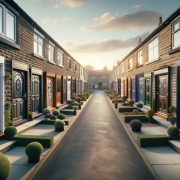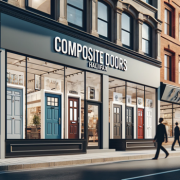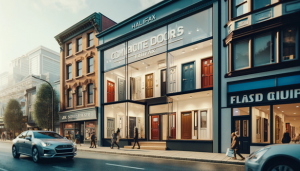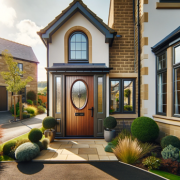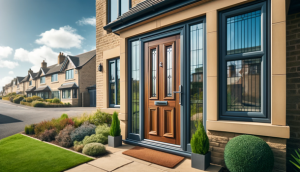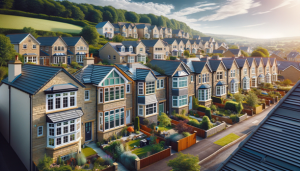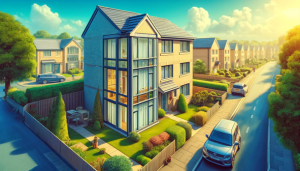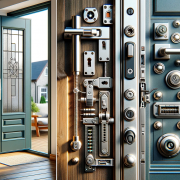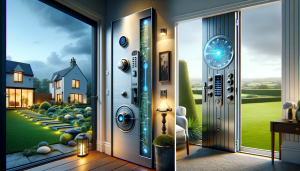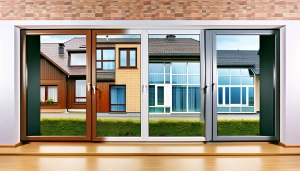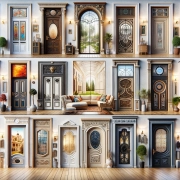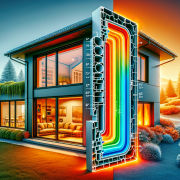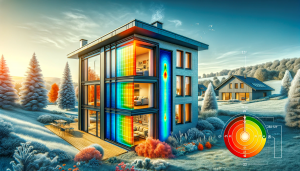Composite Doors Huddersfield
The Optimal Choice for Homeowners: Composite Doors in Huddersfield
Table of Contents
Choosing the right door for your home goes beyond mere aesthetics; it’s about enhancing security, insulation, and overall home value. For homeowners in Huddersfield, where architectural charm meets modern demands, composite doors represent a robust choice. Known for their strength, versatility, and energy efficiency, composite doors in Huddersfield are tailored to withstand the local climate while complimenting both traditional and contemporary homes.

Understanding Composite Doors
Composite doors are crafted from a blend of materials, each selected for their specific properties to create a product superior to traditional single-material doors. Typically, these doors consist of a solid timber core, wrapped in a durable, weather-resistant skin such as Glass Reinforced Plastic (GRP). This construction not only ensures robustness but also offers a high degree of thermal insulation.
Composition and Materials
The core of a composite door usually includes wood, insulating foam, and a frame made from uPVC or aluminium for additional strength. The outer skin made from GRP or thermoplastic helps protect against the elements, making the door tough against physical attacks and resilient against harsh weather conditions common in Huddersfield.
Advantages Over Traditional Doors
Compared to wooden or uPVC doors, composite doors excel in durability, requiring minimal maintenance. They resist fading, warping, and cracking, which are common problems in wooden doors due to moisture and temperature changes. Composite doors also provide better security and insulation than most uPVC doors, making them a cost-effective choice in the long run.
Benefits of Composite Doors for Huddersfield Homes
Huddersfield’s varied climate demands a door that can handle everything from cold, damp winters to occasional warm, wet summers without compromising on performance.
Durability and Weather Resistance
Composite doors stand up excellently against the region’s weather challenges. The materials used in composite doors are chosen for their ability to withstand extreme temperatures and moisture, preventing common issues like swelling and rotting which significantly extends the door’s lifespan.
Enhanced Insulation
One of the standout features of composite doors is their superior thermal efficiency. The insulating core and tight seals keep cold drafts out and warm air in, which is particularly beneficial for energy conservation in the colder months. This feature helps Huddersfield homeowners reduce heating costs, contributing to the doors’ overall energy efficiency.
Design and Aesthetics
A wide range of finishes and styles makes composite doors a fitting choice for any home aesthetic, from classic Victorian to sleek, minimalist designs.
Style Versatility
Whether you’re looking to maintain the historic charm of a period property or complement a more modern façade, composite doors come in various styles and colours. From solid colours that mimic traditional paint to wood grain effects that replicate the classic wooden door appearance, there is a design to suit every taste.
Customisation Options
Beyond just colour and finish, composite doors offer options for customised hardware such as handles, letterboxes, and knockers, available in various metals and finishes. Homeowners can also choose from different types of glazing that not only enhance the door’s appearance but also improve privacy and security.
Security Features of Composite Doors
The security provided by composite doors is unrivalled, especially when compared to traditional door options available in Huddersfield.
Advanced Locking Systems
Most composite doors feature sophisticated multi-point locking systems as standard. These locks engage at several points along the door frame, significantly enhancing the door’s resistance to forced entry.
Structural Strength
The combination of a solid core and a tough, durable outer shell gives composite doors substantial physical integrity. This robust construction makes them nearly impervious to common burglary methods, such as drilling, cutting, or bumping, providing peace of mind to homeowners concerned about security.
Installation Process and Maintenance
Proper installation and maintenance are critical to ensuring that your composite door functions optimally and lasts for many years. Huddersfield homeowners will find that investing in professional installation and regular maintenance can significantly enhance the door’s performance and durability.
Professional Installation is Key
For optimal security and energy efficiency, composite doors must be precisely installed. It’s important to choose skilled installers who understand how to properly integrate the door into your home’s specific architectural framework. They will ensure that the door fits perfectly, eliminating gaps that could lead to drafts and increased energy bills.
Regular Maintenance Schedule
While composite doors are famed for their low maintenance, some regular upkeep is beneficial, Simply wiping the door with soapy water and a soft cloth will keep it looking fresh and new. Avoid abrasive cleaners which can damage the surface. Periodically check and lubricate the door’s hardware, such as hinges and locks, to keep them operating smoothly. Regularly inspect the door’s seals to ensure they are intact, as broken seals can affect insulation and security.
Cost-Effectiveness and ROI
Investing in a composite door can be seen as investing in the future of your home. The initial outlay is offset by the long-term benefits that these doors bring to homeowners in Huddersfield.
Understanding the Investment
The cost of a composite door can vary depending on size, design, and additional features. However, the return on investment is realized through increased energy efficiency, reduced maintenance costs, and enhanced security, which can contribute to overall property value.
Long-Term Savings
Composite doors offer excellent insulation, which helps reduce heating costs, particularly during Huddersfield’s cold winters. Furthermore, the durability of these doors means you will spend less on repairs and replacements compared to traditional wooden or uPVC doors.
Choosing the Right Supplier in Huddersfield
Selecting the right supplier is crucial in ensuring you get a quality product that meets your expectations and fits seamlessly with your home’s aesthetics.
Local Suppliers and Their Offerings
It’s beneficial to choose a supplier who understands the local climate and typical architectural styles of Huddersfield. Look for suppliers with positive reviews and those who provide good warranty terms.
Criteria for Selection
When choosing a supplier, consider the following. Ensure the doors meet industry standards for security and energy efficiency. Good suppliers offer excellent pre-sale and after-sale services. Verify that the supplier provides professional installation services to ensure your door performs as promised.
Composite doors represent a smart choice for Huddersfield residents, combining security, energy efficiency, and style adaptability. By selecting the right door, ensuring professional installation, and carrying out regular maintenance, you can enhance both the aesthetic appeal and functionality of your home. The investment in a composite door not only improves your immediate living environment but also contributes to the long-term value and desirability of your property.

